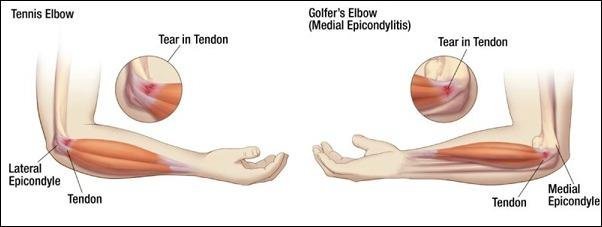
Elbow pain can be a bother for many young people which can cause considerable disability. There are many reasons for having elbow pain. Elbow is used in many ways by us in our daily lives, like lifting an object, hug someone, cook a meal, or throw a ball. Because it bends in so many directions, it’s susceptible to injury. There are few conditions which can cause acute pain e.g. acute injuries, stress or overuse injuries, diseases e.g. arthritis (osteoarthritis, rheumatoid arthritis).
The most common causes of elbow pain are overuse injuries. People use their elbow s when participating in many sports that involve throwing and/or swinging e.g. Cricket ,Tennis etc. These activities often involve repetitive motions of the wrist, elbow, and shoulder, which can lead to extra strain and stress being placed on these muscle groups.
s when participating in many sports that involve throwing and/or swinging e.g. Cricket ,Tennis etc. These activities often involve repetitive motions of the wrist, elbow, and shoulder, which can lead to extra strain and stress being placed on these muscle groups.
Some of the reasons that simple activities can result in elbow pain are as follows:
An overuse injury can occur with either sports or exercise participants or during routine daily and work-related duties. This is particularly true for people who perform repetitive tasks as part of their job duties. These can occur using a computer mouse, working with tools, using lab equipment, or even having to pull or lift something like a package or furniture.
Tips to avoid overuse injuries
This overuse condition often occurs in non-tennis players from improper lifting and carrying of objects, or from performing activities that are highly repetitive in nature like washing and squeezing clothes. The activities translate force to the outside of the elbow, causing inflammation and micro-tears in the tendon.
performing activities that are highly repetitive in nature like washing and squeezing clothes. The activities translate force to the outside of the elbow, causing inflammation and micro-tears in the tendon.
This painful condition caused by damage to the elbow where the tendons that extend your wrist and fingers originate from i.e. lateral epicondyle of humerus. Hence, in medical parlance it is also called lateral epicondylitis. The primary muscle that allows your wrist to extend, the ECRB (extensor carpi radialis brevis), is usually the tendon involved.
Although it can occur at any age usually happens in patients in their 40s and 50. Sometimes it is due to sports activities like golf or racquet sports and sometimes from work activities, but, just as often, it seems to happen after lifting or carrying objects. The pain is worst with gripping, grasping and wringing activities and can be provoked by typing or using a computer mouse with the wrist extended.
Orthopaedic doctors make a clinical diagnosis by listening to patient’s complaint and examining the elbow. Sometimes one may require MRI scan in chronic cases.
Initial treatments for tennis elbow are conservative in the form of splints, changing certain activity patterns and avoiding painful activities with anti-inflammatory analgesics. Sometimes physical therapy in the form of stretching and strengthening may help. A cortisone injection or PRPP (Platelet Rich Plasma Precipitate) may cure the patients. In very few cases less than 5-10% may require surgery for effective symptom relief.
This is a condition that causes pain on the inner side of the elbow or involving the medial epicondyle, henceforth the name medial epicondylitis in orthopaedic parlance. It’s the result of overuse or general wear and tear of the tendons, bones, and muscles in this area, which are used for grasping and wrist flexion. Activities that require repetitive gripping motions, such as throwing, rock climbing, racket sports, or weight training, can often lead to golfer’s elbow. The elbow may feel stiff. Hands and wrists may feel weak. Elbow pain sometimes translates into pain in other areas of the body.
Tips to prevent Golfer’s elbow
Treatment in acute painful epicondylitis
In addition, follow a healthy diet, get plenty of rest, and exercise a few times per week. Your symptoms should subside within two weeks of treatment. If one doesn’t see improvement after this time, then please consult your Orthopaedic doctor. Further treatments may include cortisone or platelet-rich plasma (PRP) injections or physical therapy. Very few require surgical treatment.
Exercises to prevent pain
